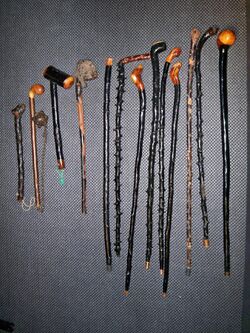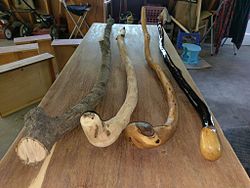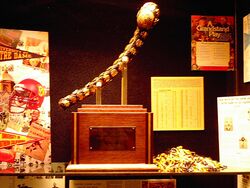Engineering:Shillelagh (club)
A shillelagh (/ʃɪˈleɪli, -lə/ shil-AY-lee, -lə; Irish: sail éille or saill éalaigh[1] [ˌsˠal̠ʲ ˈeːlʲə], "thonged willow") is a wooden walking stick and club or cudgel, typically made from a stout knotty blackthorn stick with a large knob at the top. It is associated with Ireland and Irish folklore.
Other spelling variants include shillelah, shillalah, and shillaly.
Etymology
The name shillelagh is the Hiberno-English corruption of the Irish (Gaelic) form sail éille, where sail means "willow" or "cudgel" and éille is genitive for iall meaning "thong", "strap", "leash", "string", etc.[2][3]
As an alternate etymology, Mrs. S. C. Hall as well as P. W. Joyce have written that the name may have derived from the wood being sourced from forest land in the village or barony of Shillelagh, County Wicklow. The geographic name Shillelagh derives from Síol Éalaigh, or "Descendants of Éalach" in English.[4][5][6][7]
Construction
Shillelaghs are traditionally made from blackthorn (sloe) wood (Prunus spinosa) or oak.[8] With the scarcity of oak in Ireland the term came increasingly to denote a blackthorn stick,[9] and indeed blackthorn stick is sometimes glossed as equivalent to shillelagh.[10][11]
Wood from the root was prized since this would be used for the knob,[8] and was less prone to crack or break during use.
Curing and polishing
Most commonly, the chosen wood would be placed up a chimney to cure for a duration of several months to several years;[lower-alpha 1] the accumulated layer of soot gave the shillelagh its typical black shiny appearance.[4][8]
The less frequent methods were to bury the shank in a dung pile, or even in slaked lime.[4] The stick may require protection from its dung bath by being wrapped in well-greased oiled brown paper (steeped in hog's lard or oil).[12]
Both of the previous methods would be finished with oils or sealants, etc. A further coat of special soot finish may be applied,[8] or a mixture of black lead and grease rubbed on with woolen cloth to a polishing finish.[12] Some examples may just be given a coat of black paint.[13]
Rarer still was brining, where the shank was placed into a basin of saltwater. The saltwater, being a hypertonic solution, would pull moisture from the shank with little warping.[citation needed] One isolated case of this brining method being used, by Charlotte Brontë's uncle named Hugh, has been documented. Hugh Brontë is said to have rubbed train oil (whale oil) on the stick using chamois leather, and applied magpie blood to give it a darker appearance.[14][15]
Dimensions
They are commonly the length of a walking stick (distance from the floor to one's wrist with elbow slightly bent),[citation needed] or rather longer, about 4 feet or 5 feet, as opposed to the walking stick measuring about 3 feet.[16] In the broad sense, the Shillealagh bata or sticks could include short mallets only 1 – 2 feet long to long poles 6 – 9 feet.[8]
Fittings
Shillelaghs may be hollowed at the heavy "hitting" end and filled with molten lead to increase the weight beyond the typical two pounds; this sort of shillelagh is known as a 'loaded stick'.[lower-alpha 2][8][17]
The loaded types needed to have its knob fitted with iron ferrules to maintain structural integrity.[17] But the sticks also have iron ferrules fitted onto their narrow end as well.[14][18][8] Shillelagh may also have a heavy knob for a handle which can be used for striking.[9] Shillelaghs may also have a strap attached, similar to commercially made walking sticks, to place around the holder's wrist.[19]
History
The shillelagh was originally used for settling disputes in a gentlemanly manner — like a duel with pistols or swords. Modern practitioners of bataireacht study the use of the shillelagh for self-defence and as a martial art. Of the practice, researcher J. W. Hurley writes:
Methods of shillelagh fighting have evolved over a period of thousands of years, from the spear, staff, axe and sword fighting of the Irish. There is some evidence which suggests that the use of Irish stick weapons may have evolved in a progression from a reliance on long spears and wattles, to shorter spears and wattles, to the shillelagh, alpeen,[lower-alpha 3] blackthorn (walking-stick) and short cudgel. By the 19th century Irish shillelagh-fighting had evolved into a practice which involved the use of three basic types of weapons, sticks which were long, medium or short in length.[22]
Folklore and balladry
Shillelaghs are sometimes referred to in a similar context in folk songs. In the ballad "Finnegan's Wake" occurs the phrase "Shillelagh law did all engage", signifying that a brawl has broken out;[23] "shillelagh law" itself has been explained as meaning the accepted rule governing the usage of the weapon.[24]
The anti-recruiting folk song "Arthur McBride", where the recruiters are struck with a shillelagh,[25][26] and in the 19th-century song "Rocky Road to Dublin", in which references are made to fashioning a shillelagh ("I cut a stout blackthorn"), and using it ("shillalah"[27]) to hold a tied bag over one's shoulder, and using it as a striking weapon.[28]
Charles Dibdin the younger wrote a song entitled "The Twig of Shelaly",[29] later reprinted as "The Twig of Shillelah".[30]
Bing Crosby wrote a song entitled "Two Shillelagh O'Sullivan".[31]
Modern usage
The shillelagh came to be regarded as a stereotypical symbol of Irishness in popular culture,[32] particularly in an Irish-American context.
Members of a number of Irish regiments in the British Armed Forces have traditionally carried Blackthorn sticks, including officers of the Irish Guards,[33] the Royal Irish Regiment and the Royal Dragoon Guards. Officers and senior non-commissioned officers of the 1st Battalion/69th Infantry Regiment (The Fighting 69th) of the New York Army National Guard's 27th Infantry Brigade also carry shillelaghs whilst on parade.[34]
In sports, the Boston Celtics logo has a leprechaun leaning on his shillelagh, and it also features with the leprechaun on some logos of Brothers Rugby league teams in Australia. In San Diego, Padres broadcaster Mark Grant popularised the shillelagh as a rallying call, by using terms like "Shillelagh Power" to describe late-game heroics by the Padres. The success of the phrase led the San Diego Padres store to carry inflatable shillelaghs. Similarly, in the college games of American football, a Jeweled Shillelagh is the trophy given to the winner of the rivalry game between the USC Trojans and Notre Dame Fighting Irish. Professional wrestler Finlay carried a shillelagh to the ring in December 2006 as an "illegal weapon".[citation needed]
A number of items take their name from the shillelegah, including the MGM-51 Shillelagh anti-tank missile,[33] and several aircraft of the 357th Fighter Group which were named for the club, and had similar representative nose art.[citation needed] In the tabletop game Dungeons & Dragons, 'shillelagh' is a low-level spell used by casters to make simple clubs into powerful bludgeoning weapons.[35]
See also
- Rungu (weapon) - a similar club common in East Africa.
- Knobkerrie - similar club associated with Southern Africa and World War I British troops.
- Sgian-dubh - "black knife" of Scottish Highland attire
Explanatory notes
- ↑ The stick may be smeared with butter before being hung in the chimney, as a preparatory step.[4]
- ↑ These loaded versions are called by such names as smachtín (smachtín ceann luaidhe or "lead-headed cudgel"), and are the size of smaller ailpín.[17]
- ↑ There is only a vague distinction between shillelagh and alpeen (Diarmaid Ó Muirithe), though the alpeen may be longer or heavier, and be knobbed in the minds of some (P. W. Joyce).[20] An alpeen or ailpeen (Irish: ailpín) is glossed as. "thick alpenstock", "ashplant", "club", "heavy stick".[21]
References
Notes
- ↑ Barry, Michael (2013). Dublin's Strangest Tales: Extraordinary but true stories. Pavilion Books. p. 9. ISBN 9781909396449. https://books.google.com/books?id=IrO_CAAAQBAJ&pg=PT9.
- ↑ Hurley (2007), p. 121.
- ↑ Dolan, Terence Patrick (2006). "shillelagh". shillelagh. Gill & Macmillan. p. 209. ISBN 9780717140398. https://books.google.com/books?id=RN0p1uienWMC&pg=PA209.
- ↑ Jump up to: 4.0 4.1 4.2 4.3 Hall, Mrs. S. C. (1841). Traits and stories of the Irish peasantry. p. 426 note. https://books.google.com/books?id=Ev-IOz-9ruAC&pg=PA426.
- ↑ Hurley (2007), p. 119.
- ↑ Oxford English Dictionary: Etymology: < the name of a barony and village in Co. Wicklow. OED provides the following quotation: "1785 F. Grose Classical Dict. Vulgar Tongue, Shillaley, an oaken sapling, or cudgel, (Irish) from wood of that name famous for its oaks."
- ↑ Online Etymology Dictionary: shillelagh 1772, "cudgel," earlier, "oak wood used to make cudgels" (1670s), from Shillelagh, town and barony in Co. Wicklow, Ireland, famous for its oaks.
- ↑ Jump up to: 8.0 8.1 8.2 8.3 8.4 8.5 8.6 Chouinard B.A., Maxime. The stick is king: The Shillelagh Bata or the rediscovery of a living Irish martial tradition. http://www.freifechter.com/files/stick_edited.pdf. Retrieved 5 July 2011.; copy.
- ↑ Jump up to: 9.0 9.1 Colum (1988), p. 397.
- ↑ McHugh, Roland (1991). Annotations to Finnegans wake. Johns Hopkins University Press. p. 361. ISBN 9780801841903. https://books.google.com/books?id=8lxnAAAAMAAJ.
- ↑ Mabey, Richard (1978). Plantcraft: a guide to the everyday use of wild plants. Universe Books. p. 43. ISBN 9780801841903. https://books.google.com/books?id=8lxnAAAAMAAJ.
- ↑ Jump up to: 12.0 12.1 Carleton, William (1877). Ireland: its scenery, character, &c. 1. George Routledge and Sons. p. 142. https://books.google.com/books?id=oncIAAAAQAAJ&pg=PA142.
- ↑ Y (24 February 2000). How Black Is A Blackthorn?. https://www.irishtimes.com/opinion/how-black-is-a-blackthorn-1.248616.
- ↑ Jump up to: 14.0 14.1 Wright, William (1893). The Brontës in Ireland: Or, Facts Stranger Than Fiction. Pavilion Books. pp. 283–285. https://archive.org/details/brontsinireland01wriggoog.
- ↑ Chouinard, Maxime (9 June 2014). "Shillelaghs". https://hemamisfits.com/2014/06/09/shillelaghs/.
- ↑ Hurley (2007), pp. 144, 157.
- ↑ Jump up to: 17.0 17.1 17.2 Hurley (2007), p. 148.
- ↑ Hurley (2007), p. 145.
- ↑ McCann, Sean (1972). The Fighting Irish -. Leslie Frewin. p. 153. https://books.google.com/books?id=jT-CAAAAIAAJ.
- ↑ Hurley (2007), p. 131.
- ↑ Dolan (2006) "ailpeen, alpeen", Dictionary of Hiberno-English, pp. 5–6.
- ↑ Hurley (2007), p. 347.
- ↑ Carleton, William (1996). "James Joyce: Here Comes Everyword". Manchester Memoirs (Manchester Literary and Philosophical Society) 133: 75. https://books.google.com/books?id=z3weAQAAIAAJ.
- ↑ Hurley (2007), p. 11.
- ↑ Milner, Dan; Kaplan, Paul (1983). Arthur McBride. Oak Publications. pp. 87–88. ISBN 1-783234-92-X. https://books.google.com/books?id=ZpbIDgAAQBAJ&pg=PT87.
- ↑ James, Peter (2006). Warehouse Eyes: the Albums of Bob Dylan. Lulu.com. p. 248. ISBN 9781411680845. https://books.google.com/books?id=2BucuSs84UkC&pg=PA248.
- ↑ Carleton, Will (1866). Will. Carleton's "Dandy Pat" Songster: Being a Choice Collection of Songs. Dick and Fitzgerald. pp. 59–63. https://books.google.com/books?id=ULo-AQAAMAAJ&pg=PA62.
- ↑ Milner, Dan; Kaplan, Paul (1983). The Rocky Road to Dublin. Oak Publications. pp. 58–59. ISBN 1-783234-92-X. https://books.google.com/books?id=ZpbIDgAAQBAJ&pg=PT58.
- ↑ Dibdin, Charles Isaac Mungo (1807). The Twig of Shelaly. Vernor, Hood, & Sharpe. pp. 85–87. https://books.google.com/books?id=3yNYAAAAcAAJ&pg=PA86.
- ↑ Dibdin, C., Jr. (1810). The Twig of Shillelah. T. Hughes. pp. 12–87. https://books.google.com/books?id=zzVYAAAAcAAJ&pg=PA126.
- ↑ Bing Crosby. "Two Shillelagh O'Sullivan". https://www.lyrics.com/lyric/13890566.
- ↑ Hurley (2007), p. 15.
- ↑ Jump up to: 33.0 33.1 Matusitz, Jonathan (2014). Symbolism in Terrorism: Motivation, Communication, and Behavior. Rowman & Littlefield. p. 208. ISBN 9781442235793. "More recently, the MGM-51 antitank missile [..] was baptized as the "Shillelagh". Officers of the Irish Guards are given shillelaghs upon graduation - just like Irish Regiments of the British Army in the past"
- ↑ Alan Feuer (18 March 2005). "Green Camouflage and Purple Hearts". The New York Times. https://www.nytimes.com/2005/03/18/nyregion/18fighting.html.
- ↑ Dungeons & Dragons (2014). Player's Handbook (5e ed.). Wizards of the Coast. ISBN 978-0-7869-6560-1. http://dnd.wizards.com/products/tabletop-games/rpg-products/rpg_playershandbook.
Sources
- Colum, Padraic (1988). A Treasury of Irish Folklore. Kilkenny Press. pp. 397–399. https://books.google.com/books?isbn=0517676125.
- Hurley, John W. (2007). Shillelagh: The Irish Fighting Stick. Caravat Press. ISBN 978-1-4303-2570-3. https://books.google.com/books?id=ZrFMHmsMmWAC.
- O'Donnell, Patrick Denis (1975). The Irish Factions Fighters of the 19th Century. Anvil Books. https://books.google.com/books?id=sJbaAAAAMAAJ.




